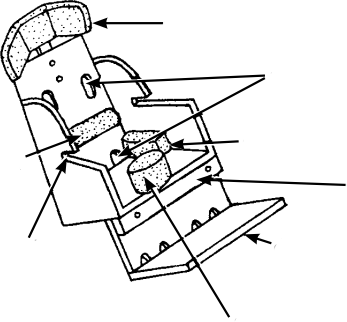Hesperian Health Guides
Chapter 65: Adaptations for Wheelchairs and Other Sitting Aids
HealthWiki > Disabled Village Children > Chapter 65: Adaptations for Wheelchairs and Other Sitting Aids
- If a folding chair is too wide, make the cloth seat and back narrower. The chair will not open as wide (but may be too high).
TOO WIDE NARROWER (BUT HIGHER) 
Be sure to check how well the child can reach to turn the wheels. - If the chair is too big from front to back, or if the child needs a better position, try a wedged cushion and padded backboard.

 padded backboardwedged cushion
padded backboardwedged cushionSome children need straps across their hips or ankles to keep a good position. (See the precaution in "Meeting the needs of the individual child, family, and community".) - If still more help is needed for positioning the child, make a sitting frame designed to meet her needs. Here is an example.
 lower-back support padnotch for removable table-boardadjustable head support (padded)holes for chest support strap and hip support straphip support padslift for tilting seat backremovable footrest with holes for foot strapsknee separatorCAUTION! Some children will need fewer or different features than those shown here. Adapt features to the needs of the particular child, and test them before making them permanent.
lower-back support padnotch for removable table-boardadjustable head support (padded)holes for chest support strap and hip support straphip support padslift for tilting seat backremovable footrest with holes for foot strapsknee separatorCAUTION! Some children will need fewer or different features than those shown here. Adapt features to the needs of the particular child, and test them before making them permanent.



The sitting frame can be used on the ground. It can be placed in a chair (or strapped into the seat of a car). It can be fitted into a wheelchair. Or make a simple wood wheelchair with all the features of the sitting frame.
Seating adaptations for specific children
The various adaptations discussed here are designed to meet specific needs of individual children, especially children with cerebral palsy. Remember that each child’s needs are different, and adaptations that are not carefully fitted to the needs of the child may do more harm than good.
- Carefully consider the child’s specific needs beforeincluding any adaptation or special seating.
- After making an adaptation, evaluate how the child uses it.
- Check often to see if it continues to help the child. An adaptation for a growing child may help her progress at one stage of development but hold her back a few weeks or months later.
This page was updated:19 Apr 2025


